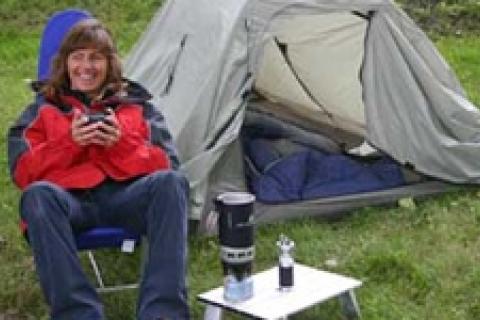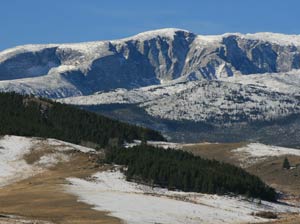
 |
| Early spring and late fall can bring surprises to campers in some regions, such as unexpected snow. |
When you go camping, you expect to escape the hustle, bustle and worries of everyday living. You can, however, unexpectedly find yourself at the mercy of Ma Nature. What happens after you possibly encounter a strong storm, snake, spider, sharp rock or other "danger" depends often on what you did prior to that encounter. It pays to be prepared and to plan ahead.
As a minimum level of protection, always plan to take along a first aid kit and have one that you know how to use. There are numerous styles and sources for these kits, but buy one and pack it along. You should also open it, study the contents, and understand what is there and how it works.
Inspect Your Site
As you reach your destination, you need to do some research and safety scouting. Before you unpack anything, stand at the specific site where your tent will be erected, look above, behind and beside for trees with dead limbs, or entire dead trees, that could be easily toppled during a storm. Strong winds, heavy rain and unexpected storms could bring those limbs and trees down onto you.
Beyond falling trees, look for possible boulders that could tumble down from cliffs and look up for exposed hillsides that could become mudslides with heavy rains. If in doubt, move to another site.
Also when thinking about rains, beware of rushing water that can come barreling down dry or desert canyons. Dry creekbeds in the Southwest can become raging rivers in only a few minutes thanks to strong, uphill and far-away storms that you might not see. Flashfloods are still a problem in many areas, and unfortunately these cause threats for campers who erect their tent near rivers. These floods are an almost common occurrence along the Appalachian Mountain range each spring. Those flood waters can rise feet in mere minutes, so look about and plan accordingly.
Next, select the perfect tent site with attention to how open and exposed it is. Don't pitch your tent on high, very exposed areas, such as bare hilltops. The view might be awesome from there, but it could also be deadly when lightning and thunderstorms pass through the region.
You should also consult the specifications of the tent you will be using or contact the manufacturer for specific details on how to properly erect and anchor the tent. Any winds beyond 20 mph can possibly collapse many tents.
Communicate Before a Problem
In this day of e-communications, it is still important to let someone know where you will be camping and when you will return. Don't rely on cellphones at the campsite to communicate your location because some phones simply don't reach out from many backcountry areas. Strong storms can also disable communication towers or disrupt, or disable, all electronic communications. Then there are the fast-moving wind and rain storms that seem to be the norm in much of America today. These also lead to widespread communication failures. You should plan ahead to survive any threat and let someone know where you will be and when you will return.
Campsites, fortunately, are places to kick back and relax. When you are relaxed and huddled around a campfire with a cup of coffee or hot chocolate in your hand, you should always keep an eye on the sky. It's that second when you suddenly look up and see a wall of dark ominous clouds approaching that you suddenly start to worry, and this moment in time could be too late. Strong storms, lightning strikes, rains and floods and other "events" from above kill hundreds each year in North America. You, however, don't have to add your name to the list.
 |
| Small, portable weather radios, like this one clipped on a backpack, can help you have a safer camping trip and avoid weather danger. |
One of the best steps in staying safe is to stay alert of the regional weather by staying informed. You can tell what's coming your way by turning on-or tuning in-to a free service provided by the National Oceanic and Atmospheric Administration (NOAA). The great news is that a battery powered, hand-held weather radio can help you stay ahead of the storms. You'll also find several lightweight, packable and portable, battery-powered models that are good for camping and hiking trips. Some models can serve double duty and serve as a home weather radio.
Like all gear, you should learn your radio's features, test the weather radio before traveling and certainly before leaving the trailhead for the campsite. Be certain you can use the radio and that you have the correct channels programmed into the receiver. NOAA gives many types of weather and hurricane reports, and most weather radios have alarms that sound and alert you to approaching danger. The reports also cover tsunamis, an ever present threat to anyone camping near any ocean. The great news is that these reports are available and updated 24 hours per day.
NOAA recommends that you understand the dangers that can be present in the area you will visit or camp in, that you pay attention, and that you have a plan to stay safe. Be mindful that dangers can change with the four seasons, and winter snow is much different than spring flooding or summer lightning storms. To receive the details, select a weather radio with a Public Alert logo and that will receive the special 1050 Hz tone alert. These are minimal standards for safety and service from a weather radio.
You will need to do some comparison shopping. Weather radios can range in prices from $20 to $200, and each model can have-or be missing-features. You should always select a model with SAME – Specific Alert Message Encoding. This permits you to fine tune the radio to receive reports for your location. The weather radio should also use batteries to be portable and have an external antenna to increase reception capabilities. Some small weather radio units now include a belt clip so you can always take it along. Some users like digital LCD readouts to help determine the radio's reception and information. Having a model with a bright exterior color, such as yellow or white, helps prevent a loss.
Surviving a Lightning Storm
As weather patterns and events seem to be taking wilder and wider swings, or extreme highs and lows across America, you should research the region's forecast where you will camp before leaving the trailhead or home and make plans accordingly. It's important to note than lightning can strike at the beginning – and end – of afternoon storms, and these type storms and strikes kill more than 20 people each year in America. There are warning signs that you could be in immediate danger.
If you suddenly taste a metallic taste in your mouth, have tingling on your skin, or your hair stands on end, move to lower ground or seek cover immediately. If outside and you hear thunder or see lightning, immediately get off any exposed ridgeline where you may be standing. You should also discard any metal or graphite objects, including backpacks with frames. Always avoid the temptation to move under trees, and move away from fence lines and metal tent poles that can receive and transfer a lightning strike. In the event that someone is struck by lightning, be mindful that the person is OK to touch and treat. Lightning's energy charge does not stay in the body.
 |
| Always search your campsite area for hidden dangers like dead trees and dead limbs in trees. |
You can better determine imminent danger from lightning by using the Flash-Bang System. Each five-second interval between when you spot a flash of lightning and hear the resulting thunder equals about 1 mile distance. Lightning can travel a considerable distance across the sky or through the ground, so lightning flashes and time-to-bang of 30 seconds or less means to take shelter immediately.
Out There and Back
It's important to note that there's a new danger lurking for campers in much of the West. As the landscape in places like Colorado, Wyoming and Montana, and popular destinations like Yellowstone National Park, have been ravaged by pine beetles, there are many dead pine trees standing. As these dead trees age, they become more susceptible to being blown over by winds. Thus, when driving, or hiking, into remote regions or into any forest for camping or adventures, you could find the trail blocked by downed trees when you return.
Carry a folding saw or ax as a means for you to open the trail and any road needed to escape. This dead-tree problem has become so big in parts of Wyoming that many state and federal regional land management offices are encouraging all backcountry travelers to keep a chainsaw – and the gas to operate it – in their vehicle. No one wants to be unexpectedly trapped in the backcountry.
The important thing is to know that dangers are present, but avoidable. Then go camping, relax and have a good time.
- 4567 views

